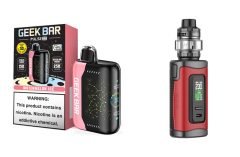Table of Contents [show]
It’s probably safe to say that the political attitude toward vaping in the United States has reached an all-time low. On one side, we have media outlets reporting about an outbreak of a terrible lung illness as if it has something to do with e-liquid vaping even though the actual cause of the illness appears to be illegal THC oil cartridges.
On the other side, we have politicians using the lung illness as an excuse to ban – or threaten to ban – all flavored e-liquids. The news isn’t all bad, though, as some appellate courts have already stopped two statewide flavor bans – at least until arguments from both sides are heard.
So, what does the future hold for the vaping industry? How could these proposed vaping bans and flavor bans impact the economy and public health? This infographic from ecigaretteempire.com summarizes the likely outcomes.
After the infographic, we’ll discuss current industry events in greater detail.

The Story Behind the Vaping and Flavor Bans
If you live in a state that isn’t yet impacted by a vaping ban or e-liquid flavor ban, consider yourself lucky because the list of impacted cities and states is getting longer. We even face the possibility of a nationwide e-liquid flavor ban, although there is a silver lining that we’ll explain in a moment.
- On September 11, President Donald Trump announced that he was directing the FDA to remove all flavored e-liquids from the market – except tobacco flavors – until those flavors receive PMTA approval, if they receive approval. The proposed flavor ban has not yet been announced by the FDA at the time of writing. It’s unclear whether the ban will actually happen, for reasons we’ll explain shortly.
- The city of San Francisco has banned all e-cigarette sales within city limits.
- Massachusetts Governor Charlie Baker has ordered a complete ban on the sale of vaping products within the state for at least four months.
- Michigan Governor Gretchen Whitmer has ordered a ban on the sale of flavored e-liquids within the state.
- Montana Governor Steve Bullock has ordered a ban on the sale of flavored e-liquids within the state for at least four months.
- New York Governor Andrew Cuomo has ordered a ban on the sale of flavored e-liquids within the state.
What Are the Likely Health and Economic Impacts of a Vaping Ban?
Whether through e-liquid flavor bans or through the FDA’s May 2020 PMTA deadline, there is a strong possibility that there will be significantly fewer vaping devices and e-liquids on American store shelves in the near future. A lack of compelling vaping products will have a domino effect that will impact you personally along with public health and the economy at large – possibly in ways that we can’t even predict yet. These are some of the likely outcomes of not having a variety of compelling vaping products available to buy.
- It’s estimated that there are around 15 million adult vapers in the United States. The vast majority of those people do not use tobacco-flavored or unflavored e-liquids. Some of those people will transition to vaping products that are still legal. A few will try alternative forms of nicotine replacement. Many will return to smoking.
- Most e-liquid companies will be unable to raise the funds necessary to get through the PMTA process and will close for good in May 2020.
- Vape shops will find themselves with significantly fewer vapor products to sell. Some shops will survive by changing their focus and becoming smoke shops or CBD stores. Others will find the transition impossible and will ultimately close.
- The American economy will lose as many as 19,000 small businesses and up to 76,000 jobs.
- We won’t have vaping as our greatest hope to stem the tide of the more than 480,000 Americans who die each year due to smoking-related causes – unless, of course, people are willing to go back to the days of the cigalike.
- Those sickened from smoking will continue to cost the healthcare system $170 billion per year.
- Workers sick from smoking will continue to cost businesses $156 billion per year in lost productivity.
Do American Vapers Have Any Reason for Hope?
Things may not look good for the vaping industry right now, but there are still several reasons to hold out hope that the future may not be as bleak as it seems.
- Research suggests that a nationwide e-liquid flavor ban would be bad for President Trump’s 2020 reelection campaign. In vital swing states such as Florida, Ohio, Pennsylvania and Michigan, Trump won by very slim margins in 2016. If vapers in those states decide to vote against Trump, it’s likely that his bid for reelection in 2020 will fail.
- Appellate courts have temporarily halted the e-liquid flavor bans in Michigan and New York. The supreme courts in both states will hear arguments from both sides before deciding whether the flavor bans are legal. In Michigan, Judge Cynthia Diane Stephens ruled that the flavor ban would do irreparable harm to small businesses across the state and that the data cited by Governor Whitmer as the reason for the “emergency” ban – the rise in youth vaping – was known by her for nearly a year before the enacted the ban. Prior to the ruling by Judge Stephens, many vape shops in Michigan had already closed permanently and were commencing bankruptcy proceedings.
- Even if nothing changes about the FDA’s intention to require all vaping product manufacturers to submit PMTAs by May 2020, some vaping products will probably make it through the application process. Reynolds submitted its PMTA for the Vuse e-cigarette in October 2019. The application surely wasn’t cheap to put together – it was over 150,000 pages long – but being a closed-system device without a history of underage use, the approval process for Vuse should be relatively straightforward. In addition, many e-liquid makers – even some makers offering many flavors and nicotine strengths – have announced that they are now preparing their PMTAs. It’s possible that some form of open-system vaping will survive the transition to full FDA regulation, after all.




